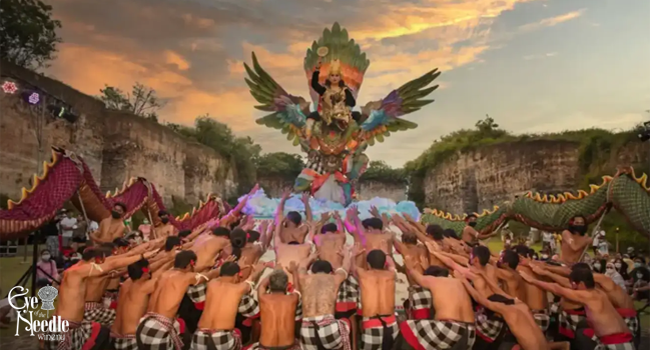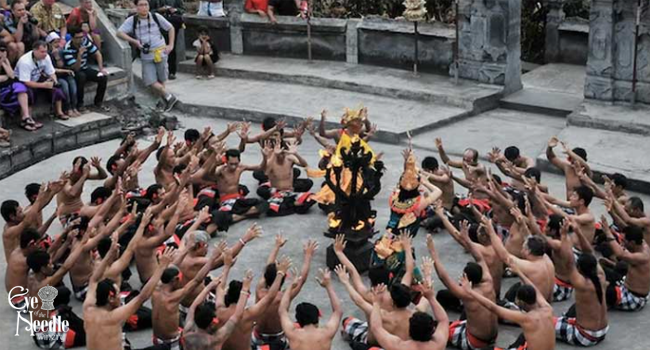Experience Sunset Bliss with Kecak Dance Bali Uluwatu

Bali, the island of the gods, is renowned for its rich cultural heritage, with traditional dances playing a crucial role in its vibrant art scene. One of the most iconic performances that capture the essence of Balinese culture is the Kecak Dance Bali Uluwatu. Often referred to as the “Ramayana Monkey Chant,” this dance is a captivating spectacle that combines rhythmic chanting, dramatic storytelling, and stunning natural backdrops, especially at the Uluwatu Temple. Visitors from around the world flock to Uluwatu to witness this unique performance that takes place at sunset, creating an unforgettable fusion of art and nature.
The Kecak Dance Bali Uluwatu is much more than a simple performance; it is a deeply rooted tradition that merges religious rituals with artistic expression. Originating in the 1930s, this dance was adapted from the ancient Sanghyang dance, a trance ritual where participants were believed to communicate with the gods. Today, the Kecak Dance has evolved into a form of storytelling, primarily depicting scenes from the Hindu epic Ramayana. The haunting chants of “cak-cak-cak” by a large male choir create a hypnotic atmosphere, drawing the audience into the tale of Prince Rama’s quest to rescue his beloved wife, Sita, from the demon king Ravana.
Witnessing the Kecak Dance Bali Uluwatu is not just about watching a dance performance; it is about immersing oneself in the cultural and spiritual fabric of Bali. As the sun sets over the Indian Ocean, the setting transforms into a mystical stage where the energies of the dancers and the audience blend, creating a powerful communal experience. The dance is a testament to Bali’s ability to preserve its traditions while adapting to the modern world’s demands for cultural tourism.
History and Origins of Kecak Dance

The origins of the Kecak Dance Bali Uluwatu can be traced back to the 1930s when it was developed as a collaborative effort between a Balinese artist named Wayan Limbak and a German painter and musician, Walter Spies. The dance evolved from the ancient Sanghyang trance ritual, where performers would enter a trance state and communicate with the spirits to repel evil. This ritualistic dance was combined with the storytelling elements of the Ramayana, creating a theatrical performance that was specifically adapted for Western tourists who were visiting Bali at the time.
Walter Spies and Wayan Limbak modified the dance by incorporating elements that would appeal to an international audience, such as the dramatic retelling of the Ramayana epic. This adaptation involved the use of a large group of male performers chanting in unison to simulate the sounds of a monkey army, hence the name “Monkey Chant.” The dancers sit in a circle, providing a rhythmic and percussive soundtrack with their voices while enacting the story of Rama and Sita. This combination of visual drama and auditory intensity made the Kecak Dance Bali Uluwatu a captivating experience that quickly became popular worldwide.
As a result of its appeal, Wayan Limbak organized tours with Balinese performers to introduce the dance to global audiences. The international exposure not only popularized the Kecak Dance but also helped establish it as one of Bali’s cultural icons, often performed at significant temples like Uluwatu, Tanah Lot, and in the heart of Ubud.
Symbolism and Meaning Behind the Kecak Dance
The Kecak Dance Bali Uluwatu is more than just an artistic performance; it is a dance rich with symbolic meaning and cultural significance. The dance is deeply rooted in Hindu mythology, particularly the Ramayana epic, which represents the eternal struggle between good and evil. In the Kecak Dance, Prince Rama symbolizes righteousness and virtue, while the demon king Ravana embodies malevolence and chaos.
Throughout the performance, the synchronized chanting of the word “cak” by the male choir creates a trance-like state, both for the performers and the audience. This chanting is believed to have a purifying effect, enhancing the spiritual experience of the dance. The circle formation of the dancers also symbolizes unity and harmony, emphasizing the importance of community in Balinese culture. This communal aspect is a reflection of the Balinese philosophy of “Tri Hita Karana,” which promotes harmony between humans, nature, and the spiritual realm.
The absence of traditional musical instruments in the Kecak Dance is another unique feature that sets it apart from other Balinese dances. The human voice is the primary “instrument” used to create the rhythmic sounds that accompany the narrative, highlighting the spiritual connection between the performers and the story they are enacting. This use of chanting and vocal percussion reinforces the themes of the Ramayana, allowing the audience to feel the intensity of the battle scenes and the emotional depth of the characters.
Structure and Choreography of the Kecak Performance
The structure of the Kecak Dance Bali Uluwatu is meticulously choreographed to provide a dynamic and immersive storytelling experience. The performance is divided into several scenes that depict key moments from the Ramayana epic. The dance begins with the male chorus forming a circle around a central fire or lamp, chanting “cak-cak-cak” rhythmically. The opening scene typically sets the stage with Prince Rama, his wife Sita, and his loyal brother Lakshmana entering the forest where they face various trials.
As the performance progresses, the energy of the dance builds up with the entry of antagonistic characters like Ravana and his demon army. One of the most dramatic scenes involves the character of Hanuman, the monkey god, who plays a pivotal role in rescuing Sita. This scene, often referred to as the “Fire Dance,” involves Hanuman performing near a circle of fire, symbolizing his supernatural powers and his devotion to Rama. The choreography, combined with the intense chanting and dramatic gestures, creates a climactic atmosphere that leaves a lasting impression on the audience.
The performance is carefully timed to coincide with the sunset at Uluwatu Temple, enhancing the visual impact of the dance against the breathtaking backdrop of the ocean and the temple perched on the cliff. This setting not only amplifies the mystical ambiance of the dance but also connects the audience to the natural beauty and spiritual essence of Bali.
The Experience of Watching Kecak Dance at Uluwatu

Experiencing the Kecak Dance Bali Uluwatu at the iconic Uluwatu Temple is an immersive cultural encounter that captivates both the senses and the soul. Performed on a cliffside stage overlooking the Indian Ocean, the dance takes place as the sun sets, casting a stunning glow across the sky. This natural backdrop, combined with the rhythmic chanting and dynamic movements of the dancers, creates an unforgettable experience that highlights Bali’s unique blend of spirituality, nature, and art.
The Kecak Dance Bali Uluwatu is renowned for its atmospheric setting. As the performers chant “cak-cak-cak” in unison, their voices echo across the cliffs, creating a powerful, almost hypnotic effect that resonates deeply with the audience. The dance itself is a fusion of drama, rhythm, and fire, with some scenes involving breathtaking fire displays that add an element of excitement and mysticism. The performance takes the audience through the journey of Rama and Sita, filled with love, betrayal, heroism, and the triumph of good over evil, all set against the breathtaking scenery of Uluwatu.
Visitors who attend the Kecak Dance Bali Uluwatu are not just spectators; they become a part of a communal experience that reflects Bali’s rich cultural and spiritual traditions. The synergy between the setting sun, the ancient temple, and the rhythmic energy of the dance creates an ambiance that is both serene and exhilarating. The experience goes beyond mere entertainment; it serves as a profound connection to Bali’s cultural roots and an appreciation for its artistry and spirituality.
Schedule and Locations for Kecak Dance Performances in Bali
While the Kecak Dance Bali Uluwatu is one of the most famous performances on the island, there are several other venues across Bali where visitors can witness this extraordinary dance. Here is a guide to some of the key locations and schedules for enjoying the Kecak Dance:
- Uluwatu Temple (Pura Luhur Uluwatu): The most iconic location to watch the Kecak Dance, performances at Uluwatu Temple typically start around 6:00 PM, perfectly timed to coincide with the sunset. The combination of the dance, the temple’s cliffside location, and the stunning ocean views makes this a popular choice for tourists.
- GWK Cultural Park (Garuda Wisnu Kencana): Another famous location to experience the Kecak Dance, the GWK Cultural Park offers daily performances that often feature additional elements, such as Ogoh-ogoh – giant statues representing mythical creatures. The shows here usually start in the evening around 6:00 PM.
- Pura Dalem Taman Kaja in Ubud: Known for its serene setting, this venue offers Kecak Dance performances every Wednesday and Saturday starting at 7:00 PM. The tranquil environment of Ubud provides a different experience compared to the cliffside drama of Uluwatu.
- Pura Dalem Ubud: Often referred to as the “Temple of Death,” this unique venue is dedicated to Rangda, the Demon Queen. The Kecak Dance shows at Pura Dalem Ubud run from Monday to Friday, providing another option for visitors in the Ubud area to experience this cultural treasure.
Each of these venues offers a unique setting that enhances the spiritual and artistic elements of the Kecak Dance Bali Uluwatu. Whether you choose to watch it against the dramatic backdrop of Uluwatu Temple or in the tranquil environment of Ubud, the performance promises an unforgettable glimpse into Balinese culture.
Kecak Dance as Part of Bali’s Cultural Tourism

The Kecak Dance Bali Uluwatu has become more than just a traditional performance; it is a significant part of Bali’s cultural tourism. Over the years, this dance has evolved into a major attraction that draws visitors from around the world, eager to witness its unique combination of storytelling, rhythm, and spiritual symbolism. The dance is often featured in promotional materials about Bali, highlighting its importance in showcasing Balinese culture to the global audience.
Cultural tourism has been a vital aspect of Bali’s economy, and the Kecak Dance Bali Uluwatu plays a central role in this. By performing in significant locations like Uluwatu Temple and Tanah Lot, the dance offers tourists a chance to experience Bali’s spiritual and cultural richness first-hand. The open-air performances, often set against the backdrop of sacred temples and natural beauty, provide a powerful context for understanding Balinese Hindu culture and its traditions.
Moreover, the Kecak Dance performances are often accompanied by other cultural activities, such as temple tours and traditional music, providing a holistic experience for visitors. Many tour packages now include visits to Kecak Dance performances, reflecting its status as a must-see attraction in Bali. This integration into the tourism industry helps preserve the dance’s cultural heritage while also adapting it for contemporary audiences, ensuring its relevance and appeal continue to grow.
Controversies and the Impact of Kecak Dance in the Modern World
While the Kecak Dance Bali Uluwatu has gained international fame and become a staple of Bali’s cultural tourism, it is not without its controversies. The adaptation of traditional Balinese rituals for the sake of tourism has sparked debates among cultural purists and modernists. Some critics argue that the commercialization of the Kecak Dance compromises its authenticity and sacred value. They believe that performing such a spiritually significant dance primarily for tourists dilutes its cultural essence.
On the other hand, proponents of cultural adaptation view the modernization and global exposure of the Kecak Dance as a positive evolution. They argue that cultural performances must adapt to remain relevant in a changing world, and the Kecak Dance Bali Uluwatu is an example of how traditional art forms can thrive in a modern context. The dance’s popularity has also helped to foster a greater understanding and appreciation of Balinese culture worldwide, opening up discussions about the balance between cultural preservation and innovation.
The impact of the Kecak Dance Bali Uluwatu in the modern world extends beyond tourism; it represents a case study in how traditional art forms can evolve while retaining their cultural significance. The debate around its commercialization and adaptation highlights the ongoing conversation about the role of tradition in a globalized world.
Experiencing the Kecak Dance Bali Uluwatu is more than just a dance performance; it is a deep dive into Bali’s cultural and spiritual heritage. This unique art form, set against the stunning backdrop of Uluwatu’s cliffs, offers a captivating journey into the heart of Balinese storytelling and Hindu mythology. For those looking to connect with the island’s cultural roots, watching the Kecak Dance at Uluwatu is a truly transformative experience that leaves a lasting impression.
By blending art, history, and the breathtaking natural scenery, Kecak Dance Bali Uluwatu continues to be one of the most memorable attractions on the island. From the mesmerizing sunset views over the cliffs of Uluwatu to the vibrant energy of the performers, every element of this performance ensures visitors leave with a deeper appreciation for Bali’s rich cultural tapestry.




Leave a Reply